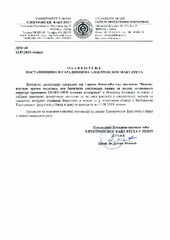Приказ основних података о дисертацији
Visoko-pouzdan prenos podataka kod bežičnih senzorskih mreža sa malom potrošnjom energije primenom 2D-SEC-DED tehnike kodiranja
| dc.contributor.advisor | Jovanović, Goran | |
| dc.contributor.other | Petrović, Branislav | |
| dc.contributor.other | Mančić, Dragan | |
| dc.contributor.other | Nikolić, Saša | |
| dc.contributor.other | Krtolica, Predrag | |
| dc.creator | Nikolić, Goran | |
| dc.date.accessioned | 2020-02-24T11:51:26Z | |
| dc.date.available | 2020-02-24T11:51:26Z | |
| dc.date.available | 2020-07-03T16:03:17Z | |
| dc.date.issued | 2019-10-25 | |
| dc.identifier.uri | http://eteze.ni.ac.rs/application/showtheses?thesesId=7175 | |
| dc.identifier.uri | https://nardus.mpn.gov.rs/handle/123456789/11970 | |
| dc.identifier.uri | https://fedorani.ni.ac.rs/fedora/get/o:1612/bdef:Content/download | |
| dc.identifier.uri | http://vbs.rs/scripts/cobiss?command=DISPLAY&base=70052&RID=534163094 | |
| dc.description.abstract | This dissertation deals with the challenges of energy efficiency in systems with limited resources of homogeneous and heterogeneous wireless sensory networks for data collection applications in real environmentals. This research covers several fields from physical layer optimization up to network layer solutions. The problem which has to be solved is viewed from three different perspectives: the energy profile of the nodes with a special emphasis on the activity of the sensing block, the network protocol with a special focus on finding an adequate coding technique that need to reduce or eliminate the request for retransmission and evaluating the range of transmission for the proposed encoding technique. If energy efficiency in wireless sensor networks is formulated as a load balancing problem then the power management unit can significantly contribute to reduction in power consumption. Power management is implemented by switching on/off individual subblocks of the sensor node independently of the hardware platform. By reducing energy consumption both an extension of the lifetime of the sensor node and sensor network, is achieved. The obtained energy profiles reveal significant differences in energy consumption of wireless sensor nodes depending in terms of external sensors number, resolution of the analog-to-digital converter, network traffic dynamics, topology of the network, applied coding techniques, operating modes and activities during the lifetime of the sensor node and other factors. In this sense, the application of combination of power aware techniques, such as the duty-cycling at system-level, and power gating at the level of sensor elements, i.e. sensors, is proposed. An evaluation of the approach shows that energy consumption reduction three orders of magnitude on average can be achieved, when these two techniques are incorporated into the sensor node. On the other hand, in the wireless sensor networks, the choice of coding scheme, i.e. channel coding depends on the application and characteristics-, model-, type-errors appearing in the wireless channel. For example, one encoding technique is preferred for use when burst errors patterns are dominant, while another coding technique is more acceptable in situations where noise causes random errors that are either single or double in nature. Bearing this in mind, along with the analysis of channel characteristics, in this dissertation, we propose a new massage coding technique by which on extend traditional protocols with aim to improve energy efficiency, while maintaining high reliability in data transmission and low latency of message transfer. Namely, channel evaluation in wireless sensor networks used in industry shows that most of the errors are of single or double nature, and burst type errors are present, but rarely. In this context, in this dissertation, an effective technique for correcting errors at a destination (FEC) based on Hamming's coding scheme of relatively low complexity, called Two Dimensional-Single Error Correction- Double Error Detection (2D-SEC-DED) was developed. The proposed encoding technique is intendet to minimize packet retransmissions, thus saving energy. Evaluation of the proposed encoding scheme shows that the code is able to correct all single errors and 99.99% of double/multiple errors. The analysis was carried out through the implementation, in MATLAB, of two versions of Rendezvous Protocol for Long Life (RPLL), called Modified RPLL (M-RPLL) and Ordinary RPLL (O-RPLL), respectively. The energy gain achieved in this way is used to improve the performance of wireless transmission, such as increasing of the transmission range. As illustration, for indoor environment characterized by the path loss exponent 4 at the target BER of 5 10 4 , the proposed encoding scheme is able to improve the transmission distance by about 18 m , or the received signal strength (RSSI) by about 8.5 dBm compared to wireless sensor networks with encoding schemes without possibility to correct errors. | en |
| dc.format | application/pdf | |
| dc.language | sr | |
| dc.publisher | Универзитет у Нишу, Електронски факултет | sr |
| dc.rights | openAccess | en |
| dc.rights.uri | https://creativecommons.org/licenses/by-nc-nd/4.0/ | |
| dc.source | Универзитет у Нишу | sr |
| dc.subject | Bežične senzorske mreže | sr |
| dc.subject | Wireless sensor networks | en |
| dc.subject | Forward error correcting codes | en |
| dc.subject | Energy efficiency | en |
| dc.subject | 2D SEC-DED encoding scheme | en |
| dc.subject | Transmit range | en |
| dc.subject | Kodovi za korekciju greške na odredištu | sr |
| dc.subject | Energetska efikasnost | sr |
| dc.subject | 2D SEC-DED šema kodiranja | sr |
| dc.subject | Opseg predaje | sr |
| dc.title | Visoko-pouzdan prenos podataka kod bežičnih senzorskih mreža sa malom potrošnjom energije primenom 2D-SEC-DED tehnike kodiranja | sr |
| dc.type | doctoralThesis | en |
| dc.rights.license | BY-NC-ND | |
| dc.identifier.fulltext | http://nardus.mpn.gov.rs/bitstream/id/52499/Disertacija.pdf | |
| dc.identifier.fulltext | http://nardus.mpn.gov.rs/bitstream/id/52500/goran-nikolic-izvestaj-komisije-dd.pdf | |
| dc.identifier.fulltext | https://nardus.mpn.gov.rs/bitstream/id/52500/goran-nikolic-izvestaj-komisije-dd.pdf | |
| dc.identifier.fulltext | https://nardus.mpn.gov.rs/bitstream/id/52499/Disertacija.pdf | |
| dc.identifier.rcub | https://hdl.handle.net/21.15107/rcub_nardus_11970 |



